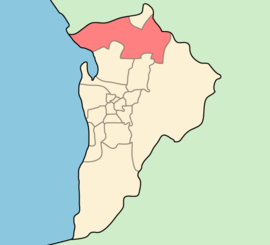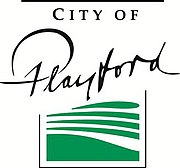|
City of Playford
 The dark area on the far side of the reservoir is the suburbs of the City of Playford. In the background are the outer northern suburbs of Adelaide, and the northern Adelaide Plains of the Gawler River. The City of Playford is a local government area of South Australia in Adelaide's northern suburbs. It was named in recognition of Sir Thomas Playford, who played a part in the development of the area, and was South Australia's premier from 1938–1965. The city covers an area of 345 km2 (133 sq mi), and is home to over 90,000 residents. Playford was the fastest growing local government area in South Australia in the 2010s. HistoryOrigins The LGA was formed in 1997 through the merger of the City of Elizabeth and the City of Munno Para, which were formed in 1955 and 1958, respectively.[2] It was named in recognition of Sir Thomas Playford, who played a part in the development of the area, and was South Australia's premier from 1938–1965.[3][4] Prior to the 1950s, most of the area surrounding the townships of Munno Para and Elizabeth were farming estates. After the end of the Second World War and the accompanying shortage of materials, the state government decided that South Australia needed to grow and become an industrialized state. A "satellite city" was planned for the Elizabeth area, and the South Australian Housing Trust initiated a housing development programme in the area, with a purchase of 3,000 acres (1,200 ha) of land. The City of Elizabeth was formed on 16 November 1955, being named after Queen Elizabeth II, who visited the city in 1963. The District Council of Munno Para was formed on 6 November 1958 following the renaming of the District Council of Munno Para East which was Proclaimed on 10 November 1853.[5] 1997 to 2010The first mayor of the City of Playford was Marilyn Baker, who had been the last mayor of the City of Elizabeth. She continued to hold that role until the 2006 council elections, when she was narrowly defeated by Martin Lindsell, the last mayor of the City of Munno Para.[6] After 1997, the council planned and built a number of new housing developments aimed at attracting young working couples and families in an attempt to rejuvenate the area. A new Civic Centre including council chambers, library, theatre and function centre was built. Other developments of the period included a new library in the Munno Para Shopping City in Smithfield, and a revamp of the Elizabeth shopping centre, including an 8-screen cinema complex.[citation needed] In 2003[7] it was announced that A$1 billion would be allocated to rejuvenate the Peachey Belt. Known as the Playford North Urban Regeneration project, it was expected that the population of the area would increase from 13,000 residents to 30,000 in 15 years and involve the demolition of most of the Housing SA homes.[7] the project has since been renamed "Playford Alive".[8][9] "As part of the 30-year Plan for greater Adelaide, significant growth and investment is pouring into Playford from business. Rapidly increasing employment coupled with new land releases has driven population growth and improved living standards."[citation needed]  2010 to presentMayor Martin Lindsell was defeated in the 2010 local council election by Glenn Docherty, the council's youngest ever mayor.[10] The council elected in 2010 started the creation of Playford Health Precinct around the Lyell McEwin Hospital.[11] The SCT Logistics Rail Freight Terminal, opened in January 2011 provided for goods and services to be transported by road and rail more efficiently and quickly.[12] Playford is to become the logistical and advanced distribution capital of South Australia.[vague][citation needed] The A$750 million expansion within the RAAF Base Edinburgh, including facilities for 7th RAR (Mechanized Army Battalion), was largely completed in 2011.[13] As of 2010[update] the council has been involved in discussions regarding expansion of the Elizabeth City Centre (the major shopping precinct in Playford) on to 30–40 hectares (74–99 acres) of land to the west of the train line.[14] As of 2011[update] the Playford council is working with the South Australian Government to release 1,000 hectares (2,500 acres) of industrial land in the greater Edinburgh Parks region, with the intention of attracting and supporting 38,000 jobs in the northern part of Adelaide.[15][16] In 2011, Mayor Docherty stated he aimed to make Elizabeth the second central business district of Adelaide. He envisaged a movement away from low density commercial and "quarter-acre block" housing to multiple storey mixed use commercial and residential developments in Elizabeth and other central parts of the council area.[17] In April 2013 the council announced its 2043 Playford Community Vision.[18] From 2012 to 2015 the council partnered with the University of Adelaide to launch the Stretton Centre, a physical home in Playford for research into regional innovation.[19] Its "anchor tenant" is the Adelaide University's Australian Workplace Innovation & Social Research Centre (WISeR). Platyford Council was assisted by a A$11.3 million grant from the Australian Government for the research centre.[20][21] The Stretton Centre includes the Stretton Research Centre (occupied by WISeR), the (new) community library, public and private community meeting spaces and the Innovation Design Lab, which is to showcase new innovations and technologies in relevant to the community. Docherty was re-elected unopposed to continue as mayor in the 2014 local government elections.[22] Royal visitsThe City of Playford (and its predecessor, the City of Elizabeth) has had a number of visits by members of the Royal Family:
CouncilCouncil consists of 16 Elected Members comprising a Mayor, and 15 Ward Councillors. The Council area is divided into five wards, with three Counicllors elected from each ward. The current council as of December 2022[update] is:[24]
Mayors of City of Playford
DemographicsThe city covers an area of 345 km2 (133 sq mi), and was estimated to have a population of 93426 in 2018.[25] Playford has been the fastest growing local government area (LGA) in South Australia over the 2010s.[3][26][27] In the five years to 2021, the Playford LGA experienced the greatest population growth of all greater Adelaide LGAs, increasing by more than 7500 residents. However, its annual rate in the 12 months to 2021 was lower than Mount Barker, Adelaide Plains and Gawler.[28] Suburbs
Services and facilitiesParks and recreationFremont Park is located immediately east of the Elizabeth City Centre. Providing recreation and leisure facilities, the park features a large lake with fountain and waterfalls, a rotunda for band performances and two playgrounds. The park also contains an adult fitness gym and is the host venue for many community events including Australia Day celebrations, school Holiday programs, weddings, and other private functions.[29] The Aquadome aquatic centre is the largest such facility in northern Adelaide. Included in this multi-purpose facility are a 50-metre pool, a beach entry leisure pool, café, a creche, outdoor picnic areas, a large carpark, and easy access to bus and rail transport. The Health Club, opened in 2009, contains a modern gym and fitness centre.[30] Located on Blackburn Road, Hillbank, Jo Gapper Park is a major regional park. It has tennis court and basketball court, which are lit at night, playground, barbecues, shelter sheds and walking trails. It has a sealed carpark which is open from dawn until dusk.[31] Stebonheath Park, Ken Patterson Reserve, Jubilee Park and the Munno Para Wetlands are other public green spaces in the City of Playford. The Playford Lakes Golf Course, which opened in 1993 as North Lakes, is located in Munno Para West, measures 5,730 m (18,800 ft) for 9 holes, and is par 70.[32] Libraries serviceThe Playford library is split across two locations: Elizabeth and Munno Para. Youth servicesYoung people have a number of services and activities supported by the council, including:
Waste management and recyclingGarbage, recycling, and green waste collection services are provided by the Northern Adelaide Waste Management Authority. Sports teamsThe City of Playford is home to several sports teams, including:
See also
References
External linksWikimedia Commons has media related to City of Playford. |
|||||||||||||||||||||||||||||||||||||||||||||||||||||||||||||||||||||||||||||||||||||||||||||||||||||||||||||||||||||||||||||||||

